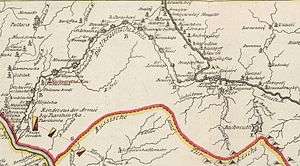Ukrainian line
Ukrainian defensive line was a Russian heavily fortified defensive line on the territory of modern Ukraine built between 1731–1764 on the lands of the Zaporizhian Sich and the Cossack Hetmanate. Built by imperial Russia, it strengthened the defense of the southern borders from Tatar incursions[1] and established military bases in approximation to the Crimea. 285 kilometers in length, it comprised 16 newly-constructed forts and 4 old forts repaired. The first stage was built from 1731–40 and subsequent construction began in the 1740s.
| Ukrainian Line | |
|---|---|
| Ukraine | |
 Ukrainian Line in 1737 | |
| Type | Defensive line |
| Site information | |
| Controlled by | Novorossiysk Governorate of the Russian Empire |
| Site history | |
| Built | 1731–1764 |
| In use | 1731–1770th |
| Materials | Natural features, moats, earthworks |
History of construction
Since the late 1720s, the Russian Empire began to actively prepare for war with the Ottoman Empire for the return of Azov and Northern Azov Sea Region. The Ukrainian line was built to prevent the Tatar incursion into the Poltava territory of the Hetmanate and the Kharkov territory of Sloboda Ukraine.[2] The line proved to be of limited success given the distance between the fortresses and that the Crimean Tatars excelled in asymmetrical warfare, here by raiding through gaps in the Russian defense lines.[3] The bulk of the work on the construction was done by Ukrainian Cossacks and peasants in 1731–1732. Every year 20 thousand Cossacks and 10 thousand peasants of Hetmanate worked on the line, who were obliged to work with their inventory and supplies, every 10th with an ox and the Cossacks with their weapons. Thousands of Ukrainians lost their lives in the construction of the line. After signing the Treaty of Belgrade in 1739 and the transfer of the Russian-Turkish border from the territory between the Samara and Oril rivers on the Azov Sea, work on the line was terminated, and with the construction of the Dnieper line in 1770–1783, the Ukrainian line lost its military defensive value.
Structure of the Line
The line ran from the Oril river to the Siverskyi Donets River. The Ukrainian line consisted of 16 forts and 49 redoubts.
Locations
| Fortress Name | Other Name | Town | Years | Coordinates |
|---|---|---|---|---|
| Borisoglebskaya fortress | Parhomiv Buyrak, after 1738 called Tenth Fortress | Krasnohrad | 1731–1742 | 48.803148, 34.330804 |
| Bilevska fortress | 49.369017, 35.452845 | |||
| Donetskaya fortress | 49.163890, 36.890280 | |||
| Efrem fortress | Yefremivka | 1731–1742 | 49.441978, 36.064019 | |
| Kozlivska fortress | Krutoyarska Fortress | Zaliniyne (neighborhood) at Skalonivky | 1731 | 49.189962, 35.169081 |
| Livenskaya fortress | Livens'ke/Mayachka | 49.109136, 34.519317 | ||
| Orel fortress | after 1738 called Ninth Fortress | Dyachkivka | 1731–1742 | 49.472411, 35.722404 |
| Ryazhskaya fortress | Ryaske | 49.173816, 34.916266 | ||
| St. Alexis fortress | Oleksiivs'ka | 1731–1742 | 49.392243, 36.264049 | |
| St. John (Ioanivska) Fortress | Oktyabrs'ke | 1731–1742 | 49.440044, 35.585453 | |
| St. Michael fortress | Michael fortress, after 1738 called Kyselna Fortress (Kisel, Kizel) | Mykhailivka | 1731–1742 | 49.321668, 36.446030 |
| St. Paraskeva fortress | Paraskivska Fortress | Paraskoviya | 1731–1742 | 49.517610, 35.868816 |
| St. Peter fortress | Peter's fortress to 1738, after called Donetsk fortress | village Petrivske | 1731 | 49.163730, 36.890191 |
| St. Theodore fortress | Theodore fortress after 1738 called Driyetska fortress or New Castle) | Zaliniyne | 1731 | 49.168657, 35.093911 |
| Slobodskaya fortress | after 1738 called Lozovaja Fortress | Pavlovka | 1731 | 49.215590, 36.578546 |
| Tambov fortress | after 1738 called Buzova castle or fortress Busov | village Mar'yivka | 1731 | 49.136049, 36.741880 |
| Vasylivska fortress | 1731–1736 | 49.164035, 34.752155 |
For defense there were 20 regiments of land militia, (14 cavalry regiments, and six infantry regiments) with about 22 000; it had 180 artillery guns and 39 mortars. In 1740 there were 18 forts and 140 redoubts. Bilevska castle was the center of the line. Until 1764, a land militia office was located there.
References
- Serhii Plokhy. "Ukraine and Russia: Representations of the Past", 2008, p. 60
- Brian Davies. "Empire and Military Revolution in Eastern Europe: Russia's Turkish Wars in the Eighteenth Century. Continuum International Publishing Group", 2011., p. 172
- Brian Davies. "Empire and Military Revolution in Eastern Europe: Russia's Turkish Wars in the Eighteenth Century. Continuum International Publishing Group", 2011., p. 205